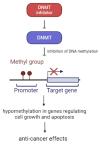The New Treatment Methods for Non-Hodgkin Lymphoma in Pediatric Patients
- PMID: 35326719
- PMCID: PMC8945992
- DOI: 10.3390/cancers14061569
The New Treatment Methods for Non-Hodgkin Lymphoma in Pediatric Patients
Abstract
One of the most common cancer malignancies is non-Hodgkin lymphoma, whose incidence is nearly 3% of all 36 cancers combined. It is the fourth highest cancer occurrence in children and accounts for 7% of cancers in patients under 20 years of age. Today, the survivability of individuals diagnosed with non-Hodgkin lymphoma varies by about 70%. Chemotherapy, radiation, stem cell transplantation, and immunotherapy have been the main methods of treatment, which have improved outcomes for many oncological patients. However, there is still the need for creation of novel medications for those who are treatment resistant. Additionally, more effective drugs are necessary. This review gathers the latest findings on non-Hodgkin lymphoma treatment options for pediatric patients. Attention will be focused on the most prominent therapies such as monoclonal antibodies, antibody-drug conjugates, chimeric antigen receptor T cell therapy and others.
Keywords: aggressive non-Hodgkin lymphoma; children and adolescents; non-Hodgkin lymphoma.
Conflict of interest statement
The authors declare no conflict of interest.
Figures
Similar articles
-
Emerging immunotherapy in pediatric lymphoma.Future Oncol. 2016 Jan;12(2):257-70. doi: 10.2217/fon.15.282. Epub 2015 Nov 30. Future Oncol. 2016. PMID: 26616565 Review.
-
Current approaches to the management of pediatric Hodgkin lymphoma.Paediatr Drugs. 2010 Apr 1;12(2):85-98. doi: 10.2165/11316170-000000000-00000. Paediatr Drugs. 2010. PMID: 20218745 Review.
-
Allogeneic Stem Cell Transplantation and Chimeric Antigen Receptor (CAR) T-Cell Therapy for the Treatment of Non-Hodgkin Lymphoma.Hematol Oncol Clin North Am. 2019 Aug;33(4):687-705. doi: 10.1016/j.hoc.2019.03.005. Epub 2019 May 10. Hematol Oncol Clin North Am. 2019. PMID: 31229163 Review.
-
Checkpoint Inhibitors and Other Immune Therapies for Hodgkin and Non-Hodgkin Lymphoma.Curr Treat Options Oncol. 2016 Jun;17(6):31. doi: 10.1007/s11864-016-0401-9. Curr Treat Options Oncol. 2016. PMID: 27193488 Free PMC article. Review.
-
Rituximab: a review of its use in non-Hodgkin's lymphoma and chronic lymphocytic leukaemia.Drugs. 2003;63(8):803-43. doi: 10.2165/00003495-200363080-00005. Drugs. 2003. PMID: 12662126 Review.
Cited by
-
Pediatric B-cell Non-Hodgkin Lymphoma: The Impact of Therapy Response and Relapse on Outcome. A Single-center Analysis.In Vivo. 2024 Nov-Dec;38(6):2812-2819. doi: 10.21873/invivo.13761. In Vivo. 2024. PMID: 39477426 Free PMC article.
-
The Art of Bioimmunogenomics (BIGs) 5.0 in CAR-T Cell Therapy for Lymphoma Management.Adv Pharm Bull. 2024 Jul;14(2):314-330. doi: 10.34172/apb.2024.034. Epub 2024 Mar 10. Adv Pharm Bull. 2024. PMID: 39206402 Free PMC article. Review.
-
Predicting T-Cell Lymphoma in Children From 18F-FDG PET-CT Imaging With Multiple Machine Learning Models.J Imaging Inform Med. 2024 Jun;37(3):952-964. doi: 10.1007/s10278-024-01007-y. Epub 2024 Feb 6. J Imaging Inform Med. 2024. PMID: 38321311 Free PMC article.
-
Management of Aggressive Non-Hodgkin Lymphomas in the Pediatric, Adolescent, and Young Adult Population: An Adult vs. Pediatric Perspective.Cancers (Basel). 2022 Jun 13;14(12):2912. doi: 10.3390/cancers14122912. Cancers (Basel). 2022. PMID: 35740580 Free PMC article. Review.
-
The Chemotherapeutic Potentials of Compounds Isolated from the Plant, Marine, Fungus, and Microorganism: Their Mechanism of Action and Prospects.J Trop Med. 2022 Oct 10;2022:5919453. doi: 10.1155/2022/5919453. eCollection 2022. J Trop Med. 2022. PMID: 36263439 Free PMC article. Review.
References
-
- Reedijk A.M.J., Beishuizen A., Coebergh J.W., Hoeben B.A.W., Kremer L.C.M., Hebeda K.M., Pieters R., Loeffen J.L.C., Karim-Kos H.E. Progress against Non-Hodgkin′s Lymphoma in Children and Young Adolescents in the Netherlands since 1990: Stable Incidence, Improved Survival and Lower Mortality. Eur. J. Cancer. 2022;163:140–151. doi: 10.1016/j.ejca.2021.12.010. - DOI - PubMed
Publication types
LinkOut - more resources
Full Text Sources







